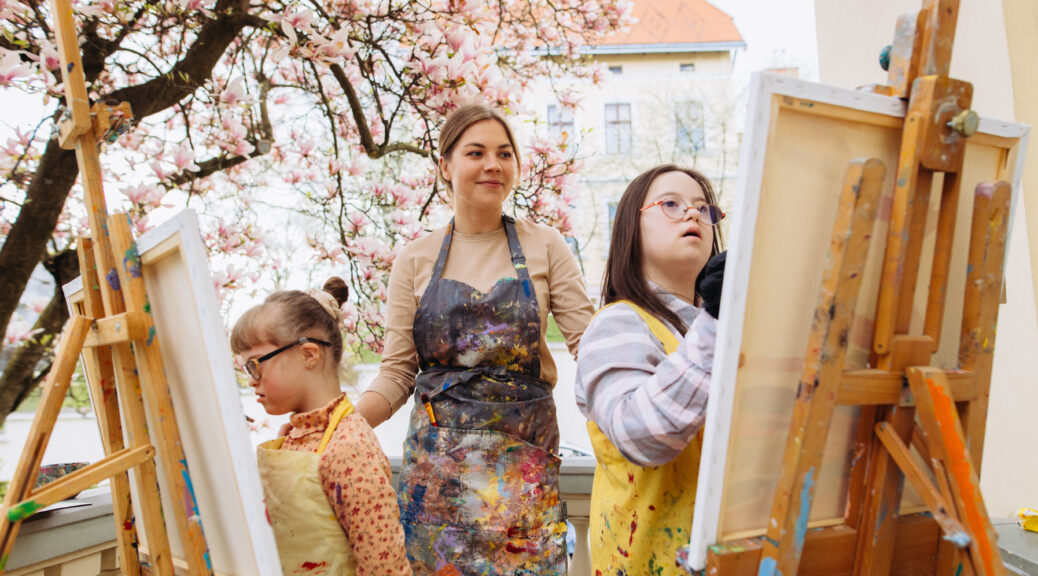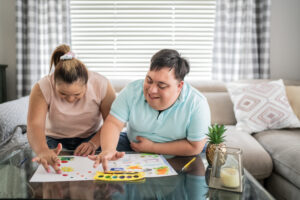Impact of the Arts: How Young People with Learning Disabilities Can Benefit from Art

For years, research has shown that the arts provide countless benefits. Whether we’re looking at a painting in a museum, doodling in the margins of a notebook or attending a live concert, the human brain responds positively to both viewing and making art. Among adults, arts participation is related to behaviors that contribute to the health of civil society, including heightened civic engagement, greater social tolerance and more.
Additionally, the arts can provide unique benefits to children with learning disabilities. The arts provide an avenue of expression that offers endless opportunities for self-expression and maximum opportunity for success. Let’s explore what makes the arts so beneficial for young people with learning disabilities, as well as some art activities to improve mental health.
How do I know which types of art a child needs?
Participating in the arts is proven to help children with learning disabilities improve their self-esteem, self-awareness, self-expression and self-identity. This holds true whether a child is participating in performance arts, visual arts or a combination of both.
For shared living providers, what is most important is not choosing the “right” type of art for a child to participate in, but exposing them to numerous artistic opportunities, noticing their favorites and using that to inform future decisions. For example, if a child seems most engaged by outdoor activities, try spending an afternoon with chalk on a nearby sidewalk, or gather small pieces of nature on your next walk – leaves, sticks, small stones – and use those for impression art when you return home.
The same type of thinking can be applied to the displaying of a child’s art after it’s completed. Depending on their personality, they may want their work to be featured front and center on the kitchen table so that the dinnertime conversation can include what they created. For another child, they may seek positive feedback in more subtle or one-on-one ways. Just as these types of situations are learning opportunities for a shared living provider, they’re also they’re also learning opportunities for the child!
How can I bring more art into my home?
The logistical answer to this question depends entirely on the size and layout of each house. Here are a few questions to help you navigate this setup:
- How readily available do you want art supplies to be? Crayons and colored pencils may be on hand at all times in some homes, while a house with white walls might avoid this at all costs.
- Where will the extra art supplies be stored? Depending on what type of skills a child is working on, it may be beneficial to tuck extra supplies away so they learn to use up what they have before seeking new tools. Alternatively, to reduce the development of a scarcity mindset, you may want all supplies to be out in the open at all times.
- What does your home’s art schedule look like? Maybe there’s a certain time of the week when all household members sit down and create something together. Or maybe there’s designated one-on-one time for a child with learning disabilities to create alongside an adult.
- What boundaries does your house have around the arts? It’s important for a child with learning disabilities to learn how to navigate a shared living space in a way that is respectful to others and honors everyone’s agreements.
Beyond the logistics, this question is quite simple to answer. Think about your own go-to audiobooks, music albums, museums, travel destinations or even style of clothing, and make a point to share those passions with your household regularly. Consider putting on a different radio station on car rides, or pointing out every single blue object you see the next time you’re heading to the grocery store. The arts are around us every single day; it’s up to us to pause, notice them and model this behavior to benefit children around us.
Is it hard to adapt the arts for different ages?
Rather than focus on age groups, we encourage you to focus on each child’s abilities and interests. If a child needs to reinforce their motor skills and better understand spatial relationships, consider using colored pencils to recreate a still life or rebuilding a nearby landmark using Legos.
In order to gauge a child’s interests in the arts, consider taking them to local museums, music stores, community theater performances, concerts and more. They may trudge through an art museum but refuse to leave a sports museum, or they may dread the idea of performing on stage but light up when the idea of being a stagehand is introduced.
However, there are some general truths about different age groups. Younger children can leverage art for schedule building, like finger painting a small poster that outlines the steps in their bedtime routine. Older children can benefit from seeing growth throughout their artistic development because, as they become more aware of their learning disability, their self-confidence may take a hit. Visualizing their progress in the arts can help them remember that this same success is possible in more challenging areas of life, too.
What are some popular arts activities for children with learning disabilities?
Interested in the performing arts? Learning to play an instrument has been proven to reduce anxiety and improve attention spans in children with learning disabilities. Memorizing lines can help build the brain’s auditory cortex, stage blocking and repetitive rehearsals can reinforce the spatial cortex and the observation of rehearsals can drastically improve facial and emotional recognition.
Are the visual arts more engaging? The power of observation drawings can’t be overstated. Mimicry and memory recall are two significant pillars of this type of art, which can be used for drawing, painting, sculpting or building. Less structured visual arts time can help develop vital problem-solving skills e.g. turn this box of fabric scraps into a new item of clothing or build a tall tower using only these crayons.
If you want to offer more independent art tools to a child in your care, consider building a supply of kinetic sand, origami papers and outdoor chalk. Each of these are simple multi-sensory art tools that can benefit all children’s growing skill sets.
Supporting your child with learning disabilities
KVC Nebraska is committed to enriching and enhancing the lives of children and families – and that includes integrating both shared living and the arts to benefit the everyday lives of children with learning disabilities.
Whether you’ve been a shared living provider for years or are currently considering it, your capacity to make a positive difference in someone else’s life is truly limitless.



